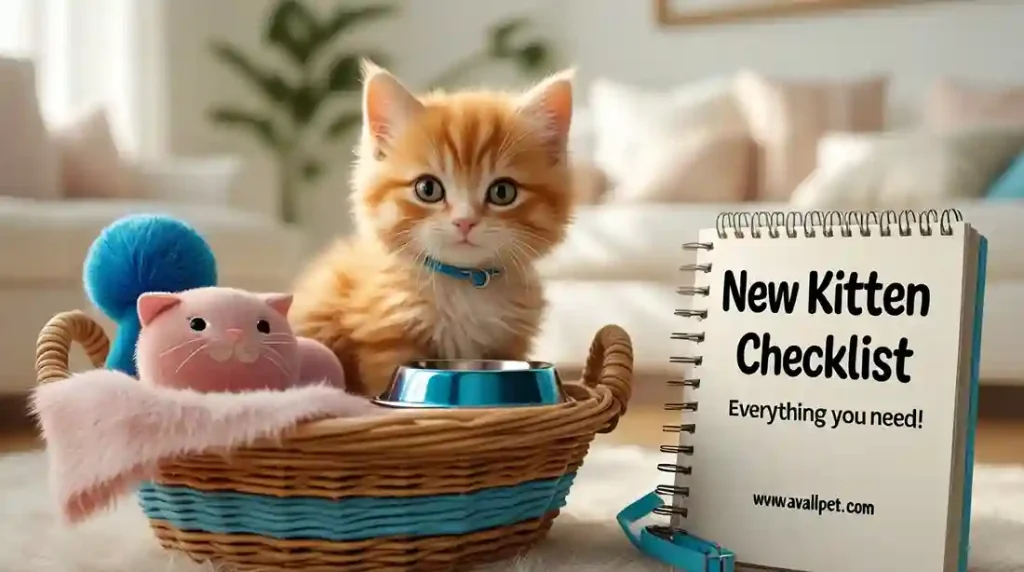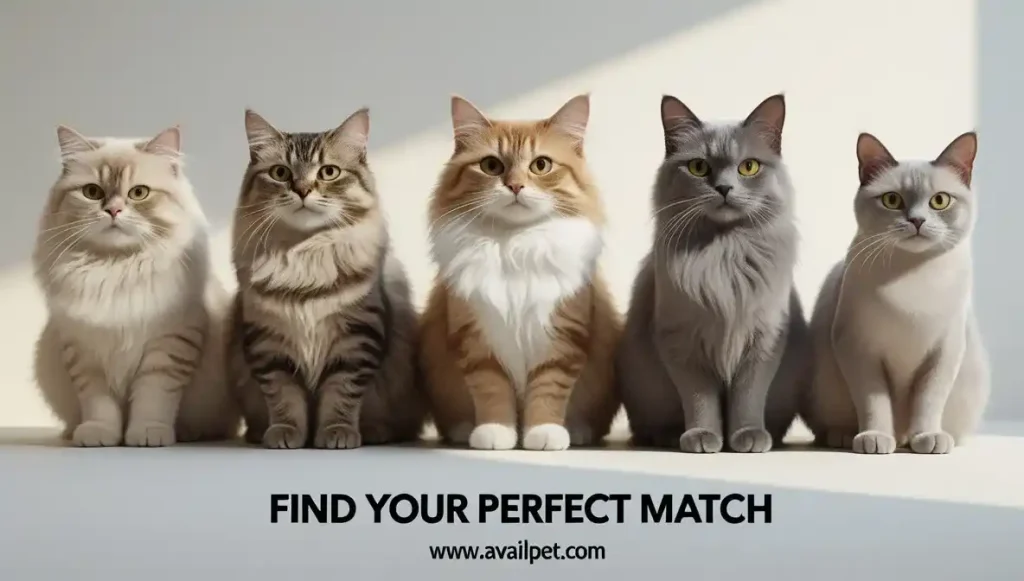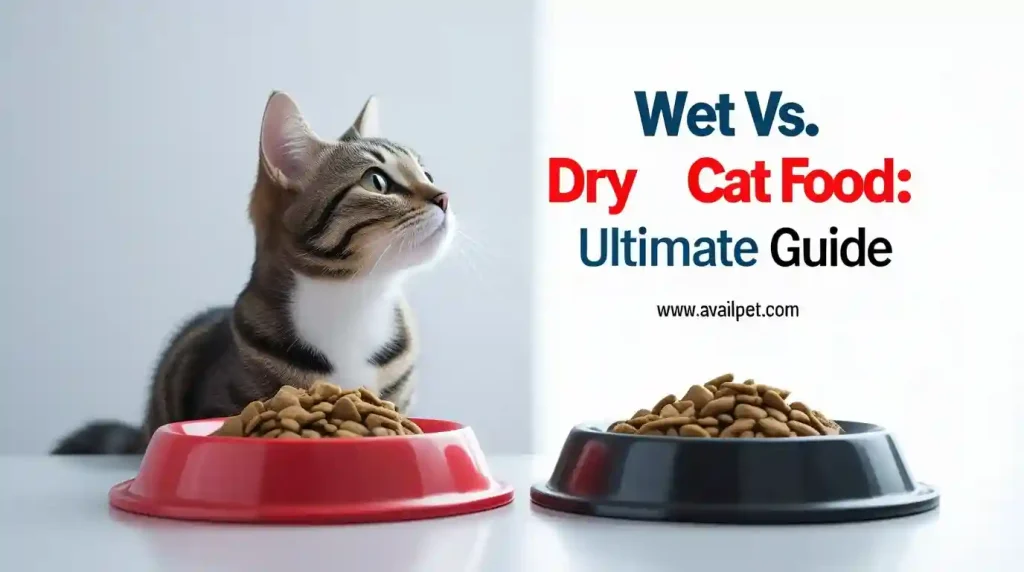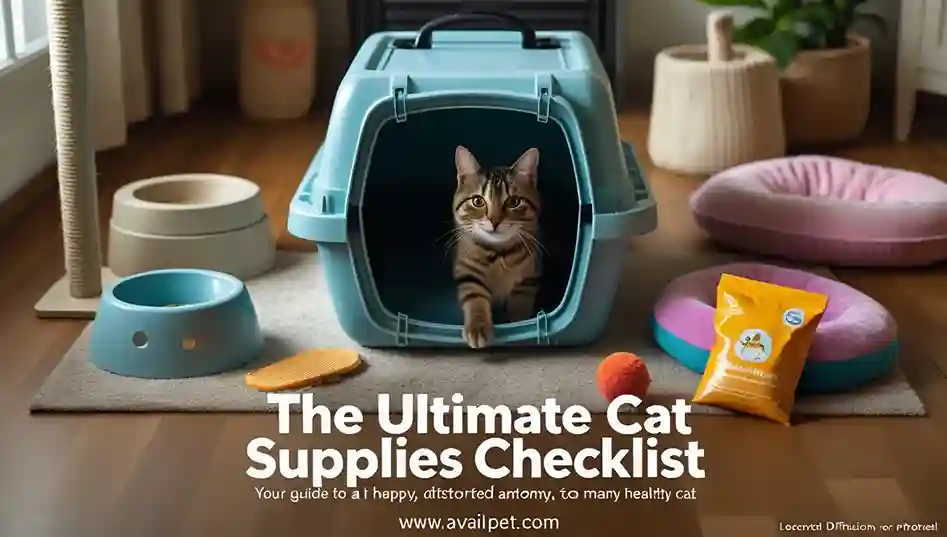Key Takeaways: Best Cat Food for Weight Loss
- Prioritize High Protein: Choose food with over 40% protein (dry matter basis) to maintain muscle mass while losing fat. Animal protein should be the first ingredient.
- Calorie Control is Essential: Weight loss requires consuming fewer calories than burned. Use a kitchen scale to measure portions accurately rather than using a cup.
- Look for Satiety Support: Foods with increased fiber and high moisture content (wet food) help your cat feel fuller while consuming fewer calories.
- L-Carnitine Boosts Metabolism: This ingredient helps the body convert fat into energy more efficiently, supporting healthy weight loss.
- Always Consult Your Vet: Rule out medical causes of weight gain and get a safe daily calorie target before starting any diet.
Watching your cat struggle with extra weight is tough. You see the lethargy, the difficulty jumping onto favorite perches, and you worry about their health. Feline obesity isn’t just about appearance—it’s a serious medical condition that can lead to diabetes, arthritis, heart disease, and a significantly shortened lifespan.
But there is hope. The right nutrition is the most powerful tool you have to help your cat shed those dangerous pounds and regain their vitality. The challenge? With so many “weight management” and “light” formulas on the market, how can you be sure you’re choosing one that truly works?
This guide is your solution. We’ve analyzed the science and consulted with veterinary nutrition experts to bring you the best cat food for weight loss in 2025. Beyond just product picks, we provide a clear, step-by-step plan to help your cat achieve a healthy weight—safely and effectively.
What to Look for in a Weight Loss Cat Food
Choosing the right food is crucial for safe and effective weight loss. The goal isn’t just reduced calories—it’s about providing optimal nutrition that supports fat loss while maintaining muscle mass and keeping your cat satisfied. Here’s what to prioritize for Best Cat Food for Weight Loss:
1. High-Protein Content
- Preserves Muscle Mass: During weight loss, cats can lose muscle along with fat. High-quality animal protein helps maintain lean muscle while promoting fat burning.
- Look For: Foods with ≥40% protein (dry matter basis) with named meat sources (chicken, salmon) as the first ingredient.
2. Controlled Calorie Density
- Fewer Calories, More Volume: Weight management foods are formulated to be lower in calories while providing essential nutrients, allowing you to feed a satisfying portion.
- Check The Label: Compare calorie content (kcal/cup or kcal/can) across products to ensure you’re selecting a lower-calorie option.
3. L-Carnitine Supplementation
- Fat-to-Energy Conversion: This amino acid derivative helps transport fatty acids into the mitochondria to be burned for energy, supporting healthy metabolism and weight loss.
- Ideal Range: Look for foods containing ≥250 mg/kg of L-carnitine.
4. Increased Fiber for Satiety
- Feel-Full Effect: Moderate fiber content (5-10% dry matter basis) helps your cat feel fuller longer by slowing digestion and stabilizing blood sugar.
- Best Sources: Look for natural fiber sources like pumpkin, psyllium, or beet pulp.
5. Moisture-Rich Formulas
- Hydration & Volume: Wet food’s high moisture content (75-80%) adds volume to meals with minimal calories, helping cats feel satisfied while supporting urinary and kidney health.
6. Essential Nutrient Balance
- Complete Nutrition: Ensure the food meets AAFCO standards for “weight control” or “adult maintenance” to prevent nutritional deficiencies during calorie restriction.
What to Avoid:
- High-carbohydrate fillers (corn, wheat, soy)
- Artificial flavors/colors
- Generic “light” formulas without specific nutritional guarantees
By focusing on these key elements, you can select a weight loss food that effectively supports your cat’s health journey while keeping them nourished and satisfied.
Our Top Picks: Best Cat Food for Weight Loss in 2025
After evaluating dozens of formulas for their nutritional profiles, clinical backing, and real-world results, our veterinary experts have selected these top-performing weight management cat foods for 2025.
1. Best Overall Prescription: Hill’s Prescription Diet Metabolic
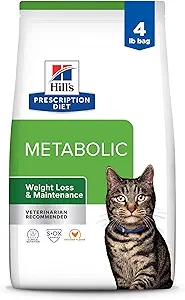
- Form: Dry & Wet
- Key Benefit: Clinically proven to activate metabolism and burn calories for 28% of cats within 30 days.
- ✅ Check Price: View on Amazon
Best For: Cats needing significant weight loss. Its unique blend of ingredients is designed to boost metabolism while maintaining muscle mass.
2. Best Over-the-Counter: Royal Canin Veterinary Diet Satiety Support

- Form: Dry & Wet
- Key Benefit: High protein and fiber content specifically formulated to promote feelings of fullness and satisfaction.
- ✅ Check Price: View on Amazon
Best For: Cats who seem constantly hungry on other diets. Excellent for appetite control and weight maintenance.
3. Best Wet Food: Purina Pro Plan OM Overweight Management
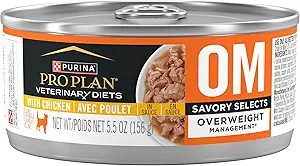
- Form: Wet
- Key Benefit: High-protein, low-carb formula with optimal calorie content. The wet food format provides extra hydration and satiety.
- ✅ Check Price: View on Amazon
Best For: Cats who prefer wet food or need additional hydration support during their weight loss journey.
4. Best for Indoor Cats: Blue Buffalo Natural Veterinary Diet W+U Weight Management
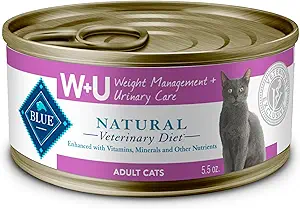
- Form: Wet
- Key Benefit: Grain-free recipe with L-Carnitine to support lean muscle mass while managing weight.
- ✅ Check Price: View on Amazon
Best For: Indoor cats needing weight management with limited ingredients. Also supports urinary health.
5. Best Budget-Friendly Option: Hill’s Science Diet Perfect Weight

- Form: Dry & Wet
- Key Benefit: Non-prescription formula shown to support healthy weight loss and maintenance in 70% of cats within 10 weeks.
- ✅ Check Price: View on Amazon
Best For: Long-term weight management and maintenance. Provides excellent value while delivering proven results.
Weight Loss Cat Food Comparison
| Product | Type | Form | Key Benefit | Best For |
| Hill’s Prescription Diet Metabolic | Prescription | Dry & Wet | Activates metabolism, clinically proven | Significant Weight Loss needing medical-grade results |
| Royal Canin Satiety Support | Prescription | Dry & Wet | High fiber & protein for fullness | Hungry Cats needing appetite control |
| Purina Pro Plan OM | Prescription | Wet | High-protein, low-carb wet food | Wet Food Lovers needing hydration & weight loss |
| Blue Buffalo W+U Weight Management | Prescription | Wet | Grain-free, supports urinary health | Indoor Cats with urinary concerns |
| Hill’s Science Diet Perfect Weight | Non-Prescription | Dry & Wet | Proven weight loss & maintenance | Budget-Conscious long-term management |
Remember: Prescription diets require veterinary authorization and are specifically formulated for therapeutic weight loss under professional guidance.
How We Selected These Foods
At AvailPet, we take our recommendations seriously. We know you’re trusting us with your cat’s health and well-being, which is why we’ve developed a rigorous, multi-factor evaluation process to ensure every food we suggest is safe, effective, and scientifically backed.
Here are the key criteria every product must meet:
- Scientific Formulation & Clinical Proof:
This is our non-negotiable top priority. We prioritize foods that have undergone controlled feeding trials and have published clinical data supporting their weight management claims, especially for prescription diets. Brands like Hill’s and Royal Canin invest heavily in research, and that evidence is paramount for our trust. - Veterinary Recommendation & Brand Reputation:
We lean heavily on brands with a long-standing, trusted reputation within the veterinary community. A product’s widespread use and recommendation by practicing veterinarians for weight management is a powerful testament to its real-world efficacy and safety. - Nutritional Profile Analysis:
We meticulously analyze the guaranteed analysis and ingredients of each product, prioritizing:- High-quality animal protein levels (>40% DMB) to maintain muscle mass
- Appropriate calorie density for weight loss
- Beneficial supplements like L-Carnitine
- Optimal fiber levels for satiety
- Safety & Recall History:
We diligently review the brands’ historical data concerning FDA recalls and consumer safety complaints. A strong track record of quality control and manufacturing safety is essential for making our list. - Palatability & Real-World Results:
The best food is useless if your cat won’t eat it. We analyze consistent feedback from countless user reviews and veterinary reports to gauge a product’s acceptance among cats, ensuring our picks are both effective and practical for long-term use.
By applying this consistent framework, we provide you with confident, trustworthy recommendations you can rely on for your cat’s weight loss journey.
Your Step-by-Step Cat Weight Loss Plan
Safe, effective weight loss requires more than just switching food—it demands a structured approach. Follow this veterinarian-approved plan to help your cat achieve and maintain a healthy weight.
Step 1: Veterinary Consultation & Calorie Calculation
- Visit Your Vet: Rule out medical conditions like thyroid issues that can cause weight gain
- Determine Ideal Weight: Your vet will help set a realistic target weight
- Calculate Daily Calories: Use this formula for most cats:
Resting Energy Requirement (RER) = 30 × (ideal body weight in kg) + 70
Example: For a 5kg cat needing to lose weight: 30 × 5 + 70 = 220 calories/day.
Step 2: Choose Your Food & Measure Precisely
- Select from Our Top Picks: Choose a food matching your cat’s needs
- Use a Kitchen Scale: Measure portions in grams for accuracy—cup measurements are unreliable
- Follow Package Guidelines: Use feeding instructions as a starting point, adjusting based on your calorie calculation
Step 3: Implement Structured Feeding
- Stop Free-Feeding: Transition from unlimited food to 2-3 measured meals daily
- Consider Puzzle Feeders: Slow down eating and provide mental stimulation
- Track Everything: Use a feeding journal or app to monitor intake and weight
Step 4: Monitor & Adjust Weekly
- Weekly Weigh-Ins: Use a pet scale and track progress
- Target Safe Loss: Aim for 0.5-2% of body weight per week (approximately ¼-½ lb per month for most cats)
- Adjust as Needed: If weight loss is too fast/slow, adjust calories by 10% and reevaluate after 1-2 weeks
Step 5: Incorporate Safe Exercise
- Daily Play Sessions: 10-15 minutes of interactive play with wand toys or laser pointers
- Environmental Enrichment: Add climbing trees and food puzzles to encourage natural movement
- Consistency is Key: Make exercise a daily routine rather than occasional intense sessions
Remember: Patience is crucial. Healthy weight loss takes 6-8 months for most cats. Regular veterinary check-ins (every 4-6 weeks) will help ensure your cat stays healthy throughout the process.
The Role of Wet Food in Weight Loss
When it comes to feline weight management, wet food isn’t just an option—it’s a strategic tool. Its unique properties make it exceptionally valuable for helping cats shed pounds safely and sustainably.
The Satiety Advantage: Fewer Calories, More Fullness
Wet food’s high moisture content (typically 75-80%) adds significant volume to your cat’s meal without adding calories. This means your cat can eat a larger, more satisfying portion while consuming fewer calories than they would with dry food. The result? A cat that feels physically full and is less likely to beg or seem hungry between meals.
Natural Calorie Control
Most wet foods are inherently less calorie-dense than dry kibble. This makes portion control more straightforward and reduces the risk of accidentally overfeeding, which is common with calorie-rich dry foods.
Metabolic and Health Benefits
- Supports Hydration: Proper hydration is crucial for overall metabolism and helps maintain optimal organ function during weight loss.
- Lower Carbohydrates: Wet foods typically contain fewer carbohydrates than dry foods, which better aligns with a cat’s natural carnivorous metabolism and can support more efficient fat burning.
For a complete analysis of how different food types compare, see our comprehensive article on Wet vs. Dry Cat Food.
Practical Tip: For best results, consider a mixed feeding approach—using a portion of your cat’s daily calorie allowance as wet food for satiety and hydration, complemented by a measured amount of weight management dry food for dental health and convenience.
FAQs About Best Cat Food for Weight Loss
How fast should my cat lose weight?
Healthy weight loss for cats is gradual. Aim for 0.5-2% of their total body weight per week. For a 15-pound cat, this means approximately 0.075 to 0.3 pounds per week. Rapid weight loss can be dangerous and lead to hepatic lipidosis (a serious liver condition).
My cat is always hungry on a diet. What can I do?
This is a common challenge. Try these strategies:
- Switch to a Satiety-Focused Food: Choose a high-protein, high-fiber formula like our top pick, Royal Canin Satiety Support.
- Incorporate Wet Food: The high moisture content adds volume to meals.
- Use Puzzle Feeders: These slow down eating and provide mental stimulation.
- Offer Low-Calorie Treats: Try green beans, a teaspoon of plain pumpkin, or commercial treats with <2 calories each.
Can I just feed less of their current food?
This is not recommended. Simply reducing portion size of a maintenance food can lead to nutrient deficiencies. Weight management foods are specifically formulated to be nutrient-dense, meaning your cat gets all the necessary vitamins and minerals even while consuming fewer calories.
What are the best low-calorie cat treats?
Opt for these when rewarding your cat:
- Commercial: Pure meat/fish freeze-dried treats (break into small pieces).
- Homemade: Cooked chicken or turkey (shredded, no skin), plain cooked green beans, or a tiny amount of plain pumpkin.
Remember: Treats should not exceed 10% of your cat’s daily calorie intake.
Conclusion & Final Recommendation
Helping your cat achieve a healthy weight is one of the most impactful things you can do for their long-term health and happiness. It requires patience, consistency, and the right nutritional strategy, but the reward—a more active, comfortable, and vibrant companion—is immeasurable.
Our top pick, Hill’s Prescription Diet Metabolic, stands out for its clinically proven ability to activate metabolism and drive effective weight loss. However, the best choice is the one that works for your cat’s specific needs, whether that’s the superior satiety of Royal Canin Satiety Support or the hydration benefits of Purina Pro Plan OM wet food.
Remember these core principles for success:
- Partner with Your Vet: Professional guidance is non-negotiable for safe weight loss.
- Prioritize Precision: Measure food with a kitchen scale and track calories meticulously.
- Embrace Patience: Healthy weight loss is a marathon, not a sprint, typically taking 6-8 months.
- Consistency is Key: Stick to scheduled meals and daily play sessions.
By combining these strategies with the right food and veterinary support, you’re not just helping your cat lose weight—you’re giving them the gift of a longer, healthier, and more comfortable life.
Sources
- WSAVA Global Nutrition Guidelines
- AAFP Feline Life Stage Guidelines
- Clinical Study – Weight Management
- Hill’s Metabolic Product Info
- Royal Canin Satiety Product Info
- Purina Pro Plan OM Product Info
- Obesity Prevention – Cornell Feline Health
Disclaimer: Always consult your veterinarian before starting your cat on a weight loss plan. Rapid weight loss can be dangerous. The products listed are suggestions and should be used under professional guidance. We may earn from qualifying purchases.

